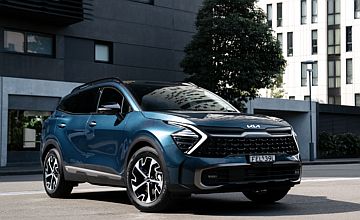Make / Model Search
OptionsCar reviews - Kia - Sportage - HybridKia modelsOverviewWe like Hybrids are shadowing EVs with advantages of long-distance range and more affordable prices Room for improvement Higher ownership costs, some handling finesse, thin feature list, no push-button start, tiny door pockets Hybrids are shadowing EVs with advantages of long-distance range and more affordable prices10 Sep 2024 By NEIL DOWLING Overview
THE problem with people buying a new car today is that they put their heart into it – literally.
Most of the decision making comes from the emotion of being attracted to a car design, the colour of the paint, the feel of the faux-leather upholstery and the ease of connectivity of the mobile phone.
Less attention is given to the ramifications of having a space-saver spare (or no spare at all), the cost of the annual (or six-monthly) service, cost of replacing those cool 20-inch tyres and the 98RON petrol that must be syphoned by the wallet before being poured into the fuel tank each week.
And for EV buyers, the weekly queue for the public charger…
With so much flak in the air, no wonder that the cost of ownership is also rarely considered.
Take the cost of a hybrid, for example. These have such a miserly fuel consumption that they’d beat a conventional petrol-engined car hands down? Usually, yes, but take the purchase price into consideration because hybrids are usually – though Toyota is an exception – considerably more expensive than a non-hybrid car.
Kia recently has trimmed the price difference back by introducing a ‘base’ model SX of its new Sportage HEV (hybrid).
The HEV SX at $45,950 (plus on-road costs) that undercuts the other HEV, the GT-Line, by a decent $6970, coming in at $52,920 plus on-road costs.
The SX in hybrid form is a modest $1900 more than the petrol, non-hybrid SX+ version (1.6-litre turbo-petrol, all-wheel drive) which given the HEV’s superior fuel economy, makes it a very attractive alternative.
But the petrol model has a load more gear than the pared-back SX HEV which is something buyers should consider, along with crunching the numbers on whether the purchase and ownership of the HEV is superior to the less expensive petrol version. See details in this review.
Driving Impressions
It’s an impressive drive, certainly outdoing the Toyota RAV4 Hybrid in terms of ease of driving; drivetrain quietness; drivability, especially acceleration; and about $1800 in savings (Kia SX+ compared with RAV4 GXL 2WD).
The better driver interaction is specifically down to the transmission. The Kia is a front-drive SUV (there’s no all-wheel drive in the HEV) with a six-speed torque convertor automatic while the RAV4 has a continuously-variable transmission (CVT) – which by comparison needs a right-boot full of revs (and some unwanted engine roar) to quickly get the car off the mark.
The Kia’s drivetrain is also smoother which passes on a less aggressive motion to the occupants.
Unlike some Kia models that have a dual-clutch transmission (DCT), the Sportage HEV has the traditional auto ‘box.
Long term, it’s a simpler, more common and importantly more reliable transmission. Unlike Volkswagen, Kia/Hyundai haven’t had big, and ongoing, problems with DCT, but there’s always concern that DCTs can be troublesome.
So, it’s a surprisingly perky and very responsive hybrid and certainly one of the best around as a rewarding and even a fun machine to drive.
The urge off the mark is reflected by the output specs. Power is a combined 169kW/350Nm compared with the petrol version at 132kW/265Nm.
It also steers pretty well and holds its line through the corners, although there’s some of the Kia magic missing – attributed to the HEV missing out on the Australian-born suspension and steering tuning that is incorporated into pretty much every other Kia.
The Sportage gets a model update next year which will have Aussie chassis input.
The ride comfort is still good, but the finesse of the handling is blurred. I guess that most drivers didn’t buy a Sportage as a sports car so this point may be lost.
There’s sufficient room inside for up to five adults, with a surprisingly roomy and comfortable rear seat. Kia quotes luggage space at 586 litres (seats up) to 1780 litres (rear seat folded flat). It has a space-saver spare wheel.
As mentioned, an update to the chassis comes next year along with the addition of one of my pet hates, the speed-limit alert buzzer. The current Sportage doesn’t have this irritating and distracting driver “aid” – but next year, in line with European models, it’ll be relentlessly dinging away under the dash unless Kia Australia, like Hyundai Australia, finds a fix.
The HEV will cruise at 100km/h at 1800rpm, which is a bit higher than the petrol auto’s 1600rpm (which has an extra gear) but it’s not an issue in terms of noise and would make only a small difference to fuel economy which would be offset by the hybrid’s frugal nature.
Hybrid switch to the 1.6-litre turbo-petrol and back again is excellent, only really discernible at low speeds. The switch is also quick, so the car maximises the electric drive and the energy stored in the battery.
Fuel consumption on test was 5.5 litres per 100km with testing on freeways, the city, suburbs and country. Kia claims 4.9L/100km which is probably possible with a greater concentration of urban driving.
That’s not as frugal as the RAV4 Hybrid, for example, at 4.7L/100km (front-drive), but at 160kW (front drive) there’s a bit more performance in the Sportage and a better driving experience.
For owners planning to tow with the hybrid, the Sportage HEV SX will tow 1650kg compared with the RAV4 front-drive at only 480kg.
And if you have a garage or a tight undercover parking bay, the Sportage is a mid-size SUV at 4660mm long, 1665mm high and 1865mm wide with a turning circle of 11.4m.
The highlight of the cabin, indeed, the whole car, is the Sportage’s dual 12.3-inch driver and infotainment screens that butt together to spread the info on a flat glass panel across the dash.
Which the HEV SX doesn’t get. Instead, it has one of the screens for infotainment and uses a more traditional-looking dash for the driver’s dials. It’s no big deal but it reflects how Kia has had to trim back features to give the SX a competitive sticker price.
There’s also a key to slide into the ignition switch to start the engine. I had to explain that to you because many of you may only be used to a push-button starter (that’s on other models), which in comparison, is a lot easier and means the key can stay in your pocket in the centre console.
There are also 18-inch alloy wheels (others get 19-inch but the 18s are actually better down the track by having a softer ride and bigger and cheaper aftermarket tyre choice), a manual-lift tailgate, satellite navigation (good), no heated seats (so immediately was crossed off my wife’s list), no panoramic roof or upmarket audio, although the sound is perfectly fine and it still has Apple CarPlay and Android Auto. Neither of the two HEV models offer all-wheel drive – and seriously, do you need it – and both have a space-saver spare in a well where it may be possible to squeeze a real spare wheel.
The Sportage has a five-star rating. Standard safety equipment includes autonomous emergency braking (AEB) with pedestrian, cyclist and car detection and junction assist; forward collision alert; lane-follow assist; lane-keep assist; blind spot collision avoidance.
It doesn’t have the blind spot view monitor or surround view monitor of the higher-spec HEV GT-Line.
Kia has a seven-year, unlimited distance warranty with roadside assist included if you keep servicing the car at an authorised Kia dealership.
Capped-price servicing lasts seven years and will cost an average of $643 a year. This fluctuates between $353 in the first year to $1042 in the fourth year. Prices are more expensive than the petrol Sportage.
Buyers looking at a hybrid because of the fuel savings should, therefore, consider all the ownership costs…
Let’s compare the HEV SX (at $45,950 plus costs) with the 1.6 petrol SX (at $44,050 plus on-road costs).
Here’s some numbers to consider: Based on a $1.60/litre average price for 91RON petrol (both the 1.6 and hybrid use this cheaper fuel), the HEV will use 588 litres over the 12,000km yearly average at a cost of $941, while the 1.6 SX will use 864 litres costing $1382 over the year.
Over three years, the hybrid will cost $2823; the petrol 1.6 will cost $4146.
The hybrid will cost $1490 to service for the first three years; the petrol 1.6 will cost $1341.
Setting aside variables including insurance, the three-year ownership cost of the hybrid is $4313 compared with $5487 for the petrol 1.6.
So, the hybrid is in front by $1174 after three years, and will continue to be cheaper in comparison to the petrol over forthcoming years.
But considering the fact the hybrid is $1900 more expensive to buy than the petrol 1.6, the savings disappear.
In fact, it is only to the end of the sixth year of ownership that the higher purchase price of the hybrid is absorbed by the cheaper running costs.
There’s heaps of rivals with hybrid engines.
Check out the Toyota RAV4 (now only available new with the hybrid engine priced from $42,260); Haval H6 Hybrid (from $42,490); Nissan X-Trail e-Power (from $50,490); Honda CR-V ($60,400); Hyundai Tucson (from $45,100); BYD Sealion (plus-in from $48,950); Mitsubishi Outlander (plug-in from $57,290); and MG HS from $49,690. Prices do not include on-road costs where applicable.  Read more12th of March 2024  Kia Sportage Hybrid joins the rangeHybridised Kia Sportage available in SX, GT-Line grades, priced from $45,950 plus on-road costsAll car reviews Alfa Romeo Alfa Romeo Abarth Abarth Alpine Alpine Alpina Alpina Audi Audi Aston Martin Aston Martin BMW BMW Bentley Bentley Chevrolet Chevrolet Chery Chery Citroen Citroen Chrysler Chrysler Dodge Dodge Cupra Cupra Ferrari Ferrari DS DS Ford Ford Fiat Fiat FPV FPV Foton Foton GWM GWM Great Wall Great Wall Holden Holden Haval Haval HSV HSV Honda Honda Hyundai Hyundai Hummer Hummer Isuzu Isuzu Infiniti Infiniti Jeep Jeep Jaguar Jaguar Lamborghini Lamborghini Kia Kia LDV LDV Land Rover Land Rover Lotus Lotus Lexus Lexus Maserati Maserati Mahindra Mahindra McLaren McLaren Mazda Mazda Mercedes-Benz Mercedes-Benz Mercedes-AMG Mercedes-AMG Mini Mini MG MG Nissan Nissan Mitsubishi Mitsubishi Peugeot Peugeot Opel Opel Proton Proton Porsche Porsche Renault Renault Ram Ram Rover Rover Rolls-Royce Rolls-Royce Skoda Skoda Saab Saab SsangYong SsangYong Smart Smart Suzuki Suzuki Subaru Subaru Toyota Toyota Tesla Tesla Volvo Volvo |
OptionsClick to share
|











Facebook Twitter Instagram